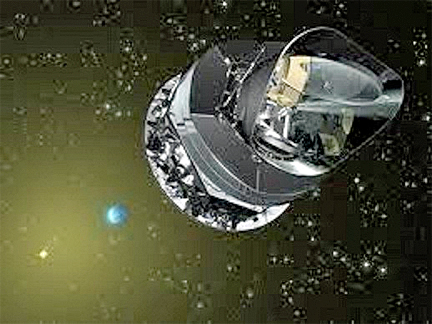Although science observations are now complete, the legacy of the Planck mission lives on.

Artistic impression of the Planck space telescope.

The anisotropies of the Cosmic microwave background (CMB) as observed by Planck. The CMB is a snapshot of the oldest light in our Universe, imprinted on the sky when the Universe was just 380 000 years old. It shows tiny temperature fluctuations that correspond to regions of slightly different densities, representing the seeds of all future structure: the stars and galaxies of today.
Copyright ESA and the Planck Collaboration—D. Ducros
Earlier this year, cosmologists working on the Planck data delivered the most precise image of the cosmic microwave background—CMB, the relic radiation that was imprinted on the sky when the Universe was only 380,000 years old. The CMB is the most accurate snapshot of the matter distribution in the early Universe. It shows tiny temperature fluctuations that correspond to regions of slightly different densities at very early times, representing the seeds of all future structure, the stars and galaxies of today.
“Planck has delivered the most precise all-sky image of the CMB that is enabling us to test a huge variety of models of the origin and evolution of the cosmos,” said Jan Tauber, ESA’s Planck project scientist. “But long and meticulous work was required before we could start exploiting this wealth of cosmological information, since the CMB is hidden behind foreground glare including emissions from material within our own Galaxy, as well as from other galaxies and galaxy clusters.”
For example, Planck has made the most extensive catalog of the largest galaxy clusters, the most massive building blocks in our Universe. Planck has also identified the densest and coldest clumps of matter in our Galaxy, cool reservoirs of material from which new stars may be born in the future—these are but two examples of the wide range of topics that the Planck data archive has provided new information.
Looking beyond the Milky Way and across cosmic history, Planck has redefined the relative proportions of the Universe’s constituent ingredients. Normal matter that makes up stars and galaxies contributes just 4.9 percent of the mass/energy density of the Universe.
Dark matter, to date detected only indirectly by its gravitational influence on galaxies and galaxy clusters, is found to make up 26.8 percent, more than previous estimates. Conversely, dark energy, a mysterious force thought to be responsible for accelerating the expansion of the Universe, accounts for 68.3 percent, less than previously thought. The data also provided a new value for the age of the Universe: 13.8 billion years.

